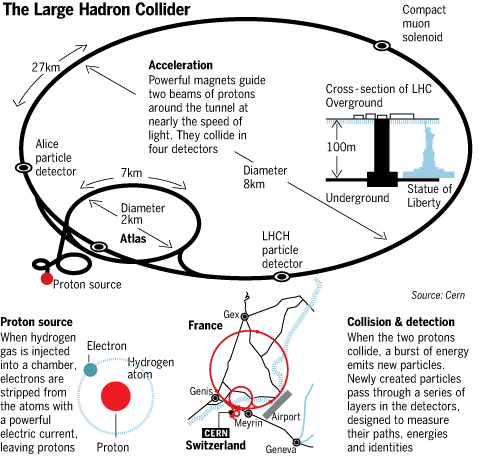CERN experiment – Glimpse of Shiva’s dance?
In all his images, Lord Shiva is depicted in a human form. His body his naked and covered with ashes. The naked body indicates that He is free from attachments to the material things of the world. Since most things get reduced to ashes when burned, ashes symbolize the essence of all things and beings in the world. The ashes on the body of the Lord signify that. He is the source of the entire creation which emanates from Him.
 |  |
Photo Credit: Giovanni Chierico Shiva's cosmic dance at CERN in Geneva |
Lord Shiva is depicted as having three eyes. The two eyes on the right and left indicate His activity in the physical world. The third eye in the centre of the forehead symbolizes knowledge (Gnana), and is thus called the eye of wisdom or knowledge. The powerful gaze of Lord Shiva’s third eye annihilates evil, and is the reason that evil-doers fear His is third eye.
September 10, 2008, HT
The symbolism is strong. As scientists at the European Organisation for Nuclear Research (CERN) near Geneva smash subatomic particles in the world’s largest experiment, Shiva, the destroyer, will be in close proximity.
On Wednesday, a powerful particle accelerator will use massive energy surges to simulate the universe’s creation with the Big Bang. And it would not have been possible without India, says Dr Amit Roy, director, Nuclear Science Centre, Delhi. “We’ve made precision-made jacks on which the 27-km machine is resting.”
Over 100 Indian scientists from institutes like the Tata Institute of Fundamental Research and the Bhabha Atomic Energy Centre are involved in the Large Hardron Collider (LHC) project.
The Department of Atomic Energy gifted a two-metre bronze statue of the Nataraja to CERN on June 18, 2004 to celebrate the centre’s India connection.
{The statue of Nataraja, the Cosmic Dancer, Dr. Aymar, DG of CERN, Dr. Anil Kakodkar, Chairman of the Indian Atomic Energy Commission and Secretary to the Government of India.}
{The statue of Nataraja, the Cosmic Dancer, Dr. Aymar, DG of CERN, Dr. Anil Kakodkar, Chairman of the Indian Atomic Energy Commission and Secretary to the Government of India.}
Indian Atomic Energy Commission boss Anil Kakodkar had then said: “The Indian scientific community is part of the quest for understanding the universe.”
{Related News:- }
{Related News:- }
Author Fritjof Capra first drew a parallel between Shiva’s dance of creation and destruction and the dance of subatomic particles in The Tao of Physics.
A plaque next to the statue quotes Capra: “Modern physics has shown that the rhythm of creation and destruction is not only manifest in the turn of the seasons and in the birth and death of living creatures, but is also the very essence of inorganic matter. For modern physicists... Shiva’s dance is the dance of subatomic matter.”
More about Shiva Cosmic Dance :-
{
In choosing the image of Shiva Nataraja, the Indian Government has acknowledged the profound significance of the metaphor of Shiva’s dance for the cosmic dance of subatomic particles, which is observed and analyzed by CERN’s physicists. The parallel between Shiva’s dance and the dance of subatomic particles was first discussed by Fritjof Capra in 1972 in an article titled ‘The Dance of Shiva: The Hindu View of Matter in the Light of Modern Physics Shiva’s cosmic dance then became a central metaphor in Capra’s international bestseller The Tao of Physics, first published in 1975 and still in print in over 40 editions around the world.
‘The Wave Structure of Matter Explains the Atomic Structure of Matter. The ‘Particle’ as the Wave-Center of a Spherical Standing Wave in Space explains the cosmic dance of Nataraja’
— FRITJOF CAPRA(1939)
A special plaque next to the Shiva statue at CERN in Geneva explains the significance of the metaphor of Shiva’s cosmic dance with several quotations from The Tao of Physics. Here is a quotation from Fritjof Capra that has been put in that special plaque ‘Modern physics has shown that the rhythm of creation and destruction is not only manifest in the turn of the seasons and in the birth and death of all living creatures, but is also the very essence of inorganic matter and for the modern physicists, then, Shiva’s dance is the dance of subatomic matter. Hundreds of years ago, Indian artists created different forms of visual images of dancing Shiva in a beautiful series of bronzes. In our time, physicists have used the most advanced technology to portray the patterns of the cosmic dance. The metaphor of the cosmic dance thus unifies ancient mythology, religious art and modern physics.’
Read the complete article on Shiva:-
}
Related Articles Posted Earlier:-
- How Dhyan Meditation can lead the way to understand the Mystery of Shiva-Shakti, Particle-Antiparticle, Dark Matter and Consciousness ?
- Non Dualism Principle by Shankar
Source and Related News:-















